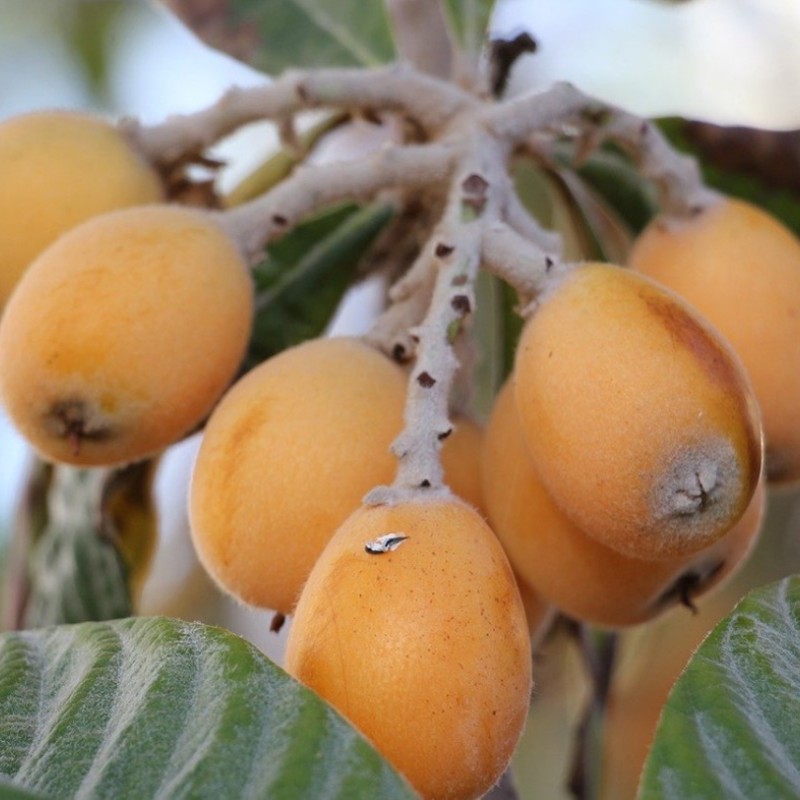
Eriobotrya japonica, better known as the Japanese loquat is an evergreen shrub or small tree indigenous to southern China. It is planted in subtropical climates, where it is often primarily grown as an ornamental plant, especially for its sweet-scented flowers and secondarily for its delicious fruit. The boldly textured foliage adds a tropical look to gardens, contrasting well with many other plants. While the Japanese loquat prefers southern or oceanic regions, it can also thrive in milder climates and even adapt to container cultivation in colder areas.
Origin: native to southeastern China, where the loquat has been cultivated for over 1,000 years. It has been later introduced to Japan, where it was further developed. The loquat is now grown in many subtropical regions around the world.
Vigour: large, evergreen shrub or small tree, with a rounded crown and short trunk. Its growth is quite rapid. The tree can grow to height of 6 m and a width of 4-5 m under good conditions, but is often smaller, about 3–4 m tall. The lanceolate leaves are 10–25 centimetres long, dark green, leathery in texture with very visible veins and serrated margin. Upper surface usually lustrous, lower surface velvety-hairy.
Rootstocks: Eriobotrya japonica seedling
Blossom: self-fertile, it can produce fruit without needing pollination from another tree. Pollination is ensured by bees, which find a good source of nectar in the flowers. Loquats are unusual among fruit trees in that the flowers appear in the autumn or early winter. The flowers are 2 cm in diameter, white and produced in stiff panicles of three to ten flowers. The flowers have a distinct sweet, heady aroma that can be smelled from a distance.
Fruits: loquat fruits, growing in clusters, are round, oval or elliptical, 3–5 cm long with average weight usually about 30-40 g. Peel is smooth or downy and yellow-orange when ripe. Japanese loquats are consumed fresh, cooked in compote, stewed or processed into preserves, jellies, juices, cordials or confectionary.
Flesh: white, yellow, or orange, juicy. Each fruit contains three or four shiny brown seeds weighing 1-3.5 g
Flavor: sweet to slightly acidic, tangy, with a refreshing apple-like taste
Harvest season: the fruit begins to ripen during spring to summer depending on the region. Flowering in loquat may extend over 1.5-2.5 months, and fruit normally ripen about 150-200 days from flowering. The fruit does not abscise after ripening but shrinks on the tree. Fruit will generally keep for 10 days at room temperature and for 30-60 days in cool storage. Trees that are vegetatively propagated will begin to bear fruit in 5 years or less, as compared to 8 to 10 years in seedling trees.
Yield: loquat yields in pots can vary greatly, but you can expect a mature loquat tree to produce anywhere from 15 to 130 kg of fruit per year. Factors influencing yield include tree size, care, and climate.
Disease resistance: Japanese loquats can be affected by various pests and diseases. Leaf and stem pests include scales, aphids, beetles, weevils, caterpillars, and nematodes. Common diseases include fire blight, leaf spot, powdery mildew, and various fungal infections to require prevention measures.
Frost resistance: for cultivation, winter temperature should be higher than -3°C and summer temperature not over 35°C. Trees can survive temperatures as low as -10°C but temperatures lower than -12°C can be lethal.
Planting and care: this species grows well on a variety of soils of moderate fertility, from light sandy loam to heavy clay. It prefers acid over alkaline soils, with pH 6.0 being optimum. Soil should be deep with good drainage and an adequate content of organic matter.